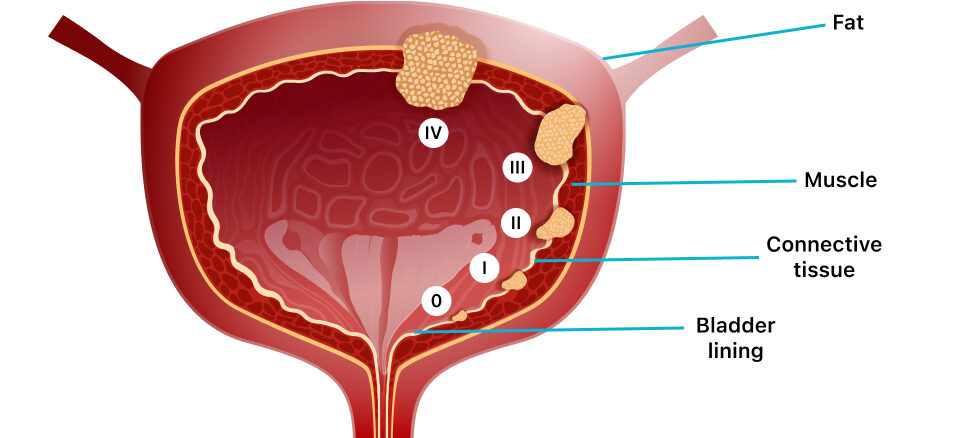A malignant tumor of the urinary bladder, commonly referred to as bladder cancer, occurs when abnormal cells grow uncontrollably in the bladder lining. It is among the most common urological malignancies, particularly affecting older adults. Understanding its causes, symptoms, diagnostic methods, and treatment options is essential for early detection and effective management.

Types of Malignant Bladder Tumors
Bladder cancer is classified into several types based on the cell origin and aggressiveness:
1. Urothelial Carcinoma (Transitional Cell Carcinoma – TCC)
- Accounts for 90% of bladder cancer cases
- Develops in the urothelial cells lining the bladder
- Can be non-muscle-invasive (localized) or muscle-invasive (aggressive)
2. Squamous Cell Carcinoma
- Represents 5-7% of cases, more common in regions with chronic bladder inflammation (e.g., due to schistosomiasis)
- More aggressive than urothelial carcinoma
3. Adenocarcinoma
- Rare, accounting for 1-2% of bladder cancers
- Originates from glandular cells, often linked to chronic bladder irritation
Risk Factors and Causes
Several factors increase the risk of developing bladder cancer:
- Smoking: The leading risk factor, responsible for up to 50% of cases
- Chemical Exposure: Occupational exposure to aromatic amines (rubber, dye, leather industries)
- Chronic Bladder Irritation: Recurrent infections, long-term catheter use, and schistosomiasis
- Age and Gender: More common in men and individuals over 55 years
- Genetics and Family History: Higher risk in those with a family history of bladder cancer
Symptoms of Malignant Bladder Tumor
Early detection improves outcomes. Common symptoms include:
- Hematuria (Blood in Urine): Present in 80-90% of cases, often painless
- Frequent Urination: Increased urgency and frequency
- Painful Urination (Dysuria): Discomfort or burning sensation
- Pelvic or Back Pain: Indicative of advanced disease
Diagnostic Procedures
Timely diagnosis is crucial for effective treatment. Common methods include:
- Urinalysis and Urine Cytology: Detects blood and cancerous cells in urine
- Cystoscopy: A thin, flexible tube with a camera is inserted into the bladder to identify tumors
- Biopsy: Tissue samples taken during cystoscopy confirm malignancy
- Imaging Tests: CT Urography, MRI, and Ultrasound assess tumor extent and metastasis
- Bladder Tumor Marker Tests: Emerging diagnostic tools for early detection
Treatment Options
The choice of treatment depends on cancer stage and type:
1. Surgery
- Transurethral Resection of Bladder Tumor (TURBT): For early-stage (non-invasive) tumors
- Radical Cystectomy: Removes the entire bladder in muscle-invasive cases
- Partial Cystectomy: Removes only the affected portion of the bladder
2. Intravesical Therapy
- Bacillus Calmette-Guérin (BCG): A type of immunotherapy for non-muscle-invasive bladder cancer
- Intravesical Chemotherapy: Mitomycin C and other agents delivered directly into the bladder
3. Systemic Chemotherapy
- Used for advanced or metastatic cases
- Common regimens include Cisplatin-based chemotherapy
4. Radiation Therapy
- Used as a bladder-sparing approach in combination with chemotherapy
- Often recommended for patients who are not surgical candidates
5. Immunotherapy and Targeted Therapy
- Checkpoint Inhibitors (e.g., Atezolizumab, Pembrolizumab): Boost the immune response against cancer cells
- FGFR Inhibitors: Target genetic mutations in advanced bladder cancer
Prognosis and Survival Rate
Bladder cancer prognosis varies by stage:
- Stage 0 & 1: 5-year survival rate of 80-95%
- Stage 2 & 3: Survival drops to 50-60%
- Stage 4: 5-year survival rate below 15%
Early detection and timely treatment significantly improve survival outcomes.
Prevention Strategies
While not all cases are preventable, some measures reduce risk:
- Quit Smoking: The most effective way to lower risk
- Avoid Occupational Carcinogens: Use protective measures in high-risk industries
- Stay Hydrated: Increased fluid intake may help flush harmful substances
- Maintain Bladder Health: Address chronic infections and urinary conditions promptly
A malignant tumor of the urinary bladder is a serious yet treatable condition if detected early. Understanding risk factors, recognizing symptoms, and seeking timely medical evaluation can significantly improve outcomes. Advances in diagnosis and treatment continue to enhance survival rates and quality of life for bladder cancer patients.

